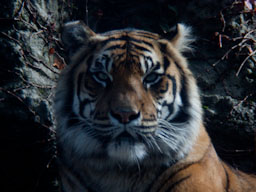Gallery - CatiodapticLens
Something I was fortunate to pick up pretty cheaply was a catiodaptic lens.
These lenses are effectively Newtonian reflectors for cameras. In my case I
picked up a 500mm effective focal length lens which, while big, is amazingly
light for the resolving power it offers. They do however do have a few
drawbacks so I figured it was worthwhile documenting it a little for other
photographers out there.
First to give you an idea of the resolving power the first image given
below was taken with a 50mm lens. From the same position the second image was
then taken with the 500mm lens. So yeah, amazing focal range for something
that is so light it quivers in a small breeze. Standard refractor lenses with
this kind of resolving power weigh in the kilogram range or heavier and are
generally reaching the point where the camera mounts on the lens and not the
other way round. My catiodaptic is well under a kilogram which makes the whole
process of lugging it about some much better.

Auckland seen through a 50mm lens, with a 1.4 crop factor that gives a field of view effectively equivalent to 75mm or so. |

And this is the skytower as seen from the same location using the 500mm lens. Thanks to the crop factor it has a field of view of about 700mm. |

|

|

|

|

The lens itself with travel box in the background. As you can see it
has been a much used instrument.
|
As you can see from the images it makes a strong wildlife lens which allows
you to keep a good distance. It does come with several drawbacks however. As
already noted it is very light and in my case it is a manual focus lens. So it
suffers from shaking and takes a while to settle down - even a light breeze
will keep it vibrating. To get the shot of the sky tower which is image number
two here I had to use my car door as a wind shield to stop the light sea
breeze coming off the harbour from shaking the lens on the tripod.
Secondly they seem to have fixed focal stops. Mine is F8 which means it can
be very tricky to use it handheld in anything other than pretty bright light.
When I can get a better camera body that can work at faster speeds than ISO400
equivalent it will become more workable. Perhaps the biggest drawback is that
they also tend to suffer from harsher bokeh. To my eye this makes framing your
target against a more neutral background like the sky or a wall of solid
colour more desirable when you can. Finally my one seems to flatten the colour
range slightly causing a more washed out image. This could be purely the age
of the lens - mine is around thirty to forty years old so I am wondering if
the lens coatings are simply quietly going off. But simply shooting in RAW and
doing a little post-processing corrects for this.
If you can live with those drawbacks you get a seriously light lens that
can be slipped into most camera packs that offers you a staggering amount of
resolving power for very little weight. I've been very happy with the use I
get out of my lens even with the drawbacks it has.
Philip R. Banks
Send Email






